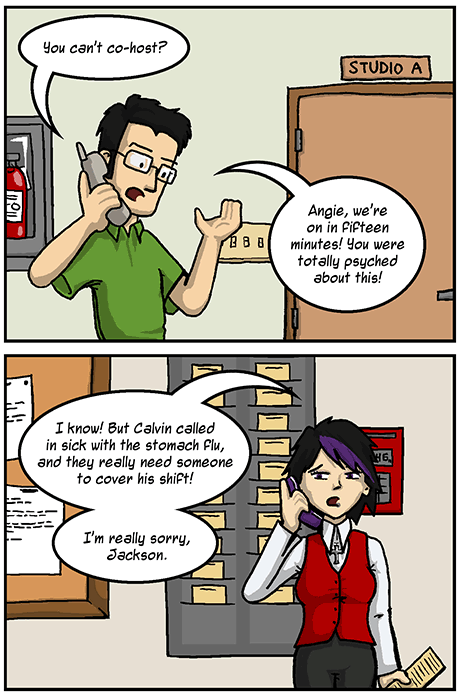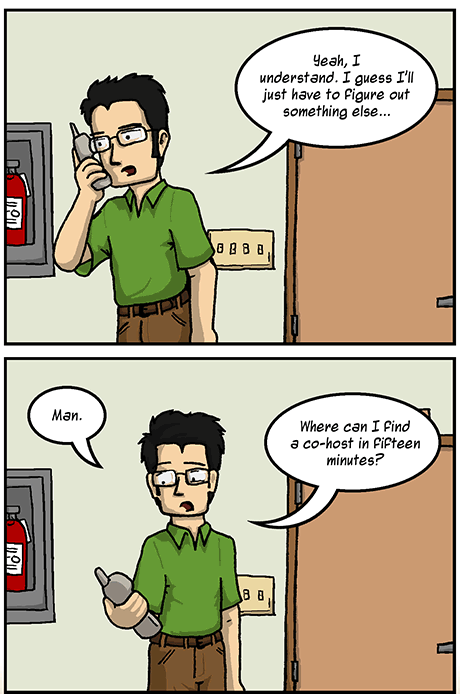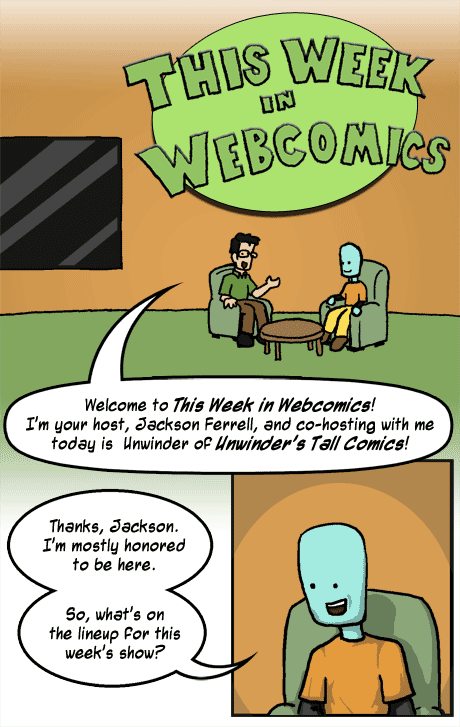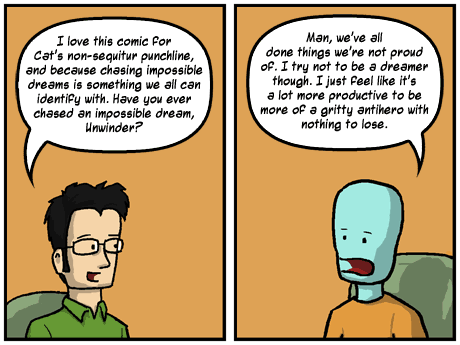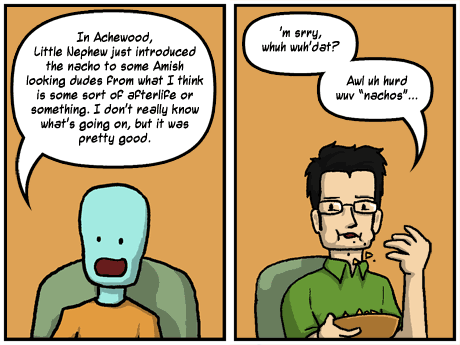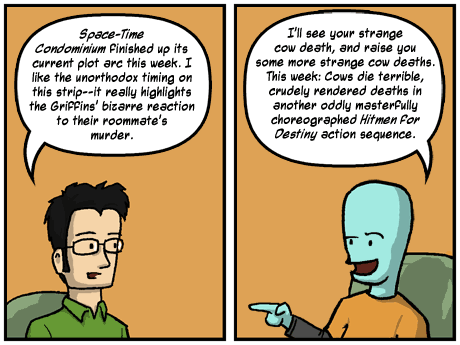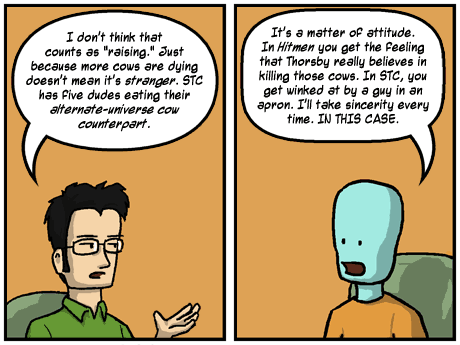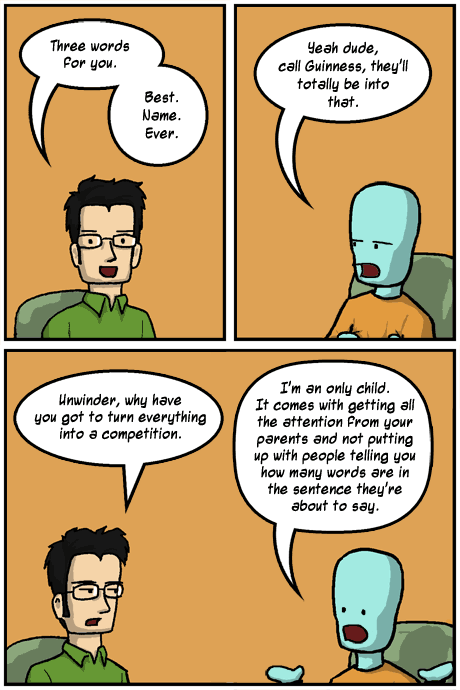
Brandon Bolt draws things. He draws things
as a professional illustrator, which makes him money, and he also draws the webcomic
Nobody Scores, which makes him stay up all night drawing. Updated roughly 2.37 times a week, Nobody Scores delivers long-form tales of spectacular failure, where continuity is optional and pain is mandatory. Its four main characters--arch-capitalist marketing exec Sara, calamity-prone crazy chick Jane, starving artist Beans, and beleaguered intellectual Raoul--suffer each other's company as they share living space, enduring such disasters as
time travel,
nanorobots, and
the typical workday. It's an anarchic, cynical celebration of everything that could possibly go wrong, and it
brings the fun.
I had the pleasure of sitting down
with Brandon Bolt at a computer some 2,000 miles from Brandon Bolt and interviewing him over email. What follows is the uncensored entirety of our conversation. The insights contained therein will shake the very foundations of your world.
JF: So, "Brandon Bolt" is a pretty awesome name. You really lucked out.
BB: I always thought it was pretty weird myself. I blame it for my alienation from humanity.
JF: (awkward silence)
So I guess we should probably talk about the comic now!
Nobody Scores is a skillfully-executed comic, but the concept is a hard sell--its humor is dark, cynical, and almost aggressively cringe-inducing. How do you find a balance between making a comic that will pay you back monetarily for what you put into it and doing what you want to do as an artist?
BB: I hear if you tape layers of newspaper between pieces of cardboard they're warmer when it gets below freezing.
Yeah--don't ask me. I try to draw stuff that doesn't bore me. Difficulty level: I am super bored. There isn't any other consideration. I am not at any level trying to market it to target audiences or anything like that. I don't even know what target audiences look like. There is no balance. If I get money, that is nice.
Because focusing on exploring the art is the only real point... If you're just going to stitch together another Snuffy Smith to plague the world for another 75 years, what's the point? Better to make it with something that's worthwhile--your chances aren't very good anyway. That's my attitude.
JF: But you do have systems in place that allow for monetary support. You sell adspace and posters; you have a discreetly-placed Paypal donation button in your sidebar.
BB: Well that is currently pizza money. Sadly! But pizzas are delicious.
JF: Since this past summer, you've abandoned straight-up infinite canvas for fixed page divisions in your comic. So you're at least making some formalistic concessions in order to facilitate a print collection. By the way, how's the fixed-page-size thing going for you?
BB: I haven't totally abandoned infinite canvas, but there is behind-the-scenes work on books and I thought I'd make it marginally easier on myself.
I am cursed however. All formats are a headache. I still have an easier time making infinite-canvas comics "work", I think, but then I give myself an infinite amount of drawing rope with which to hang myself. I've developed a theory that every person is allotted a set number of allnighters in their lifetimes. I think I may have three left. Really, I had a startling number of allnighters in me, it turned out.
So, I don't really like fixed page sizes--although I've been able to keep using many of the infinite-canvas techniques I was using before, and also, I'd kind of run out of infinite-canvas tricks to try--but limits on the amount of drawing help keep me from dying and that's real nice.
JF: On the topic of marketability...what do you think of the webcomics business model, in terms of cartoonists giving away their art for free? Do you think that it's more viable or less for career cartoonists than going a more traditional route?
BB: It is currently the least stupid of a variety of terribly stupid options, if you want to get exposure. Newspapers keep shrinking; the alt-comics press is in its usual state of woe, but keeps plugging along. Graphic novels do have the occasional breakout hit, so there's that. Webcomics are... well, they aren't actually much less static than other types of comics--the internet generates inertia--but it is possible to build an audience if you first build a comic. The competition is still not as stiff in webcomics, if you're talking raw quality. The obstacles are mainly social. You need to have high-traffic friends slash appreciators to send people your way. As for business models, I don't really have one. Nobody Scores! is a dick to merchandise because it's in such an unorthodox format. I am working on books but I don't know how exactly that will go at this point. The subsidiary t-shirts-and-tchochkes approach seems to work for some people. I am sort of interested in how Assetbar turns out, but my regular comic takes enough time as it is, and if I have to do premium content too, my shit will explode. That is, it will explode everywhere it exists and the Portland sewer management peoples are in for a fun night and I will be a big ol' mess as well.
JF: So...you're an art guy. You have a fine arts degree, and you have a career as a cartoon illustrator. I guess these things kind of come together in things like "
Nobody Scores vs. Fine Art." How do you think your background has prepared you for Nobody Scores?
BB: Doing Nobody Scores! is a betrayal of everything my education stood for and I live in fear of the day someone from college stumbles upon my cartoon and puts two and two together.
I went to a liberal arts college, and the culturally omnivorous nature of Nobody Scores! is a manifestation of my liberal-arts-geek nature, and you are this far away from me telling everybody my SAT score and nobody wants that.
It is pretty nice to be able to draw different things intelligibly and that is due to my background, I guess. Also everything you need to learn about color you learn in the first semester of art class; it just may be a while before you actually pay attention to it.
JF: SAT scores are best left back in high school. I had better change the subject quick here.
Let's talk about your characters. They're deeply flawed human beings, but it strikes me that their flaws are just strengths taken to excess. Sara's ambitious and driven, Jane approaches life with reckless enthusiasm, Beans actually cares about things, and Raoul is too smart for his own good. Am I just looking at these people too optimistically, or do they really have some redeeming qualities to them?
BB: No, sure, they do. Basically, every engaging comedic character does things we all want to do, somewhere inside our psyches: we want to get top scores on all the globally recognized indicators of success (Sara), crush those who would stand in our way (Sara), do whatever we want whenever we want (Jane), care a lot (Beans), pursue our dreams no matter how abstruse (Beans), be the smartest guy in the room (Raoul) and scorn everybody else (Raoul). At least I imagine we do. This is where unsympathetic characters can insert their hooks into you, if you let them.
So, good sides in a nutshell: Sara is productive and responsible (at least at basic day-to-day tasks), Jane is fun to be around, Beans won't betray you (unless you've really goaded him into it), and Raoul is knowledgeable, even expert in a variety of academic spheres.
The primary flaw of all of them, really, is self-centeredness and callousness, which manifests itself in different ways, depending on the character.
JF: It's interesting how often the characters' selfishness actively contributes to a given comic's catastrophe. Their own selfishness ironically undermines the pursuit of their own aims and ambitions.
BB: The tragic flaw! Sometimes I do that. But fate is a fickle beast in Nobody Scores! and its misfortunes do not hew strictly to dramatic conventions. Sometimes, ridiculous shit just happens despite the characters' best-laid plans.
JF: In
another interview, you noted that you try not to let any one character's perspective become too privileged. Is there any of the cast that you struggle to maintain that balance with?
BB: The machine of the comic has three nodes; the fourth character, Raoul, sort of operates in orbit. Of the three central nodes, I have found that Sara and Jane are by far the stronger personalities and Beans tends to get overwhelmed. This is partially because Beans is softer overall, and partially because his sphere--artistic expression--doesn't generate as many plots as the others do. So I have to tell myself to push Beans out there more every now and then.
JF: I usually close out these interviews by asking the cartoonist to share a few of their favorite webcomics, but it occurs to me--if I do that, I am basically asking you to reduplicate your links page. You follow print comics fairly assiduously, so what are a few of your favorite print comics? What's a title or two that's worth shelling out money for?
BB: Well, I don't know that I've been following them
assiduously these days, but...Lio is my favorite newspaper comic and there's
a book.
Two books! Also, in entirely different veins from Nobody Scores!, there is the work of Jason Lutes--I greatly recommend the
two Berlin books that are out; Eric Shanower's
Age of
Bronze books, a cartoon retelling of the
Iliad; and if I had to pick a print cartoonist I want all web cartoonists to read it's
Kyle Baker.
JF: Thanks for all your responses, Brandon.
BB: I am always glad to respond to things! Well sometimes I prefer to stand inert but this is not one of those times.





